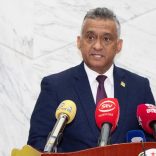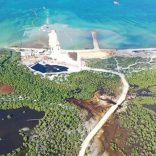Mozambique: Police say teams mobilised to rescue Maputo kidnapping victim – Watch
Hidden debts: Court hears how Proindicus collapsed – AIM report

Photo: Noticias
The fraudulent company Proindicus, supposedly set up to guarantee Mozambican coastal security, had effectively collapsed by 2016, when the technical team from the contractor, the Abu Dhabi based group Privinvest, left the country, according to Arlindo Ngale, a former officer in the Mozambican navy, who became head of the Proindicus technical and logistics department.
Ngale was testifying on the 42nd day of the trial before the Maputo City Court of 19 people accused of various crimes in connection with Proindicus, and two other fraudulent companies, Ematum (Mozambique Tuna Company) and MAM (Mozambican Asset Management), all effectively owned by the security service, SISE.
The coastal security solution embodied by Proinducus involved radar stations along the length of the Mozambican coast, in contact via satellite with an onshore Command and Control Centre, and a fleet of interceptor vessels in the Mozambique Channel.
But by 2016, Ngale said, not a single radar station was functioning, and the licence allowing Proindicus to use the satellite signal had expired.
Ngale blamed Privnvest for the radar fiasco. Of the 16 radar stations specified in the supply contract between Proindicus and Privinvest, only nine had been installed. One of the others, in Quissanga district, in the northern province of Cabo Delgado, was not set up because of problems with the access road. Another could not be installed, because it was missing the radar tower.
Two of the stations could not work because Privinvest did not provide the configurations needed for the satellite signal. At Ponta de Ouro, in the far south, at Vilankulo, in Inhambane province, and at Metangula, on Lake Niassa, work did not even begin on the foundations for the radar stations.
There were also problems with the electricity supply. Ngale said five of the stations needed generators of their own. The other 11 could be connected to the national electricity grid, but each of them demanded a dedicated medium voltage transmission line and a 22 kva transformer.
“The equipment demands a lot of power, and that’s an additional cost”, said Ngale,
As for the Proindicus boats, against Ngale’s advice, the number ballooned from 14 to 45, mostly small, interceptor speedboats. Most of them were stationed in the northern port of Pemba, and there was simply nowhere where they could all be moored. The lack of mooring space meant that some of the larger boats were just left at anchor in the Bay of Pemba, while smaller vessels were beached.
In the Bay, the boats were vulnerable to storms and cyclones. One was torn from its anchor, and blown into the nearby mangrove forest where it was damaged.
Ncale said he had warned the then chairperson of Proindicus, Eugenio Matlaba, of the mooring problem. Matlaba asked for quotations for buying pontoons (floating structures against which the boats could be moored). But nothing came of this.
Of all the Proindicus assets, the only ones in reasonable condition are six single engine aircraft (probably because they are in air force hangars).
“The coastal protection solution isn’t working today”, said Ngale. “To make it work, the radar stations must all be operational, and we need the satellite signal to establish the connections between the radars, the planes, the boats and the Command and Control Centre”.
Ngale recalled a key meeting on 25 April 2013, between the senior Proindicus staff, and a Privinvest team headed by Jean Boustani, who would later become notorious for handling millions of dollars of Privinvest bribes. Also present was Detelina Subeva, a manager at the bank Credit Suisse, handling its loan to Proindicus, She told US prosecutors in 2019 that she was one of three Credit Suisse bankers whom Boustani had bribed.
The meeting altered the supply contract between Proindicus and Privinvest, greatly increasing the number of boats Proindicus would buy. Unaware that the decision had already been taken, Ngale argued against the changes. He thought the 14 boats Privinvest was committed to under the original contract were quite sufficient.
Replacing them with the much smaller DS15 speedboats was a bad idea, given weather conditions in the Mozambique Channel. The smaller, lighter speedboats would struggle against the high waves that are frequent in the Channel. Furthermore, the larger vessels could carry much more fuel and thus stay at sea longer than the speedboats.
Privinvest also wanted to replace three twin engine planes with six single engine craft. Again Ngale objected – a twin engine aircraft was much safer, he thought, since if one engine failed, the pilot might rely on the other to return to safety. “Maritime spotter planes need two engines”, he stressed.
But he was overruled, since it seemed that Boustani had already come to an agreement with the Proindicus head of finance (and later chairperson), Antonio do Rosario.
The Privinvest argument, from a German named Peter Kuhn, was that Proindicus did not have the experience to handle large vessels, so it should stick to speedboats, which would be faster than large vessels and easier to maintain.
When judge Efigenio Baptista asked why his technical opinion had been ignored, Ngale replied “it’s very difficult to change things when the decisions have already been taken”.
The April 2013 meeting did not discuss anything as vulgar as money – but the result of dramatically increasing the number of boats which Privinvest sent to Proindicus was to increase the size of the Credit Suisse loan – from 372 million to 622 million dollars.
More money for Privinvest for boats of dubious value, and more bribes for Detelina Subeva and her friends. Nothing at all for the Mozambican people who ended up with beached boats and non-functioning radar stations.












Leave a Reply
Be the First to Comment!
You must be logged in to post a comment.
You must be logged in to post a comment.